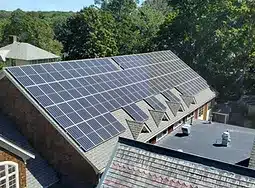Energized by the Sun: A Church Solar Installation Inspires
At Peace Dale Congregational Church in Rhode Island, we installed rooftop solar that substantially reduced our carbon footprint and saved us $15,000-17,000 per year in the cost of electricity. Our story serves as a useful model for other community organizations to minimize the use of fossil fuels while simultaneously offering financial savings.

The story began in 2020 when the church president formed a Green Team. We began with a small group who quickly defined our mission as promoting “conservation and environmental practices in our church, our homes, and our communities.” Shortly after initially emphasizing straightforward projects such as recycling efforts, community gardens, etc., we asked ourselves if a major solar installation on the church might be possible. The sanctuary of the church is of historical significance, and we suspected it was inappropriate for solar additions. However, the much younger educational wing of the church has a large south-facing roof that offered potential for rooftop solar cells. Because the church is widely used by community groups and outreach programs, our electricity use is considerable with an annual bill of $15,000-17,000/year. Going solar would drastically reduce our carbon footprint and simultaneously reduce a cost that could be diverted to other useful projects.
A first-step was to have an energy audit performed by RISE, a company devoted to energy efficiency services. As a follow-up, we researched solar companies and requested input and bids from four companies. All indicated the viability of solar installation, but the cost estimates varied widely. After careful deliberation, SolPower was selected to work with us on this job. The plan proposed the installation of enough panels (114) to generate 100% of our electricity usage. The configuration is for a 50kV system, approximately 6-7 times greater than the typical home residence system. The solar panels have a 25-year warranty, which guarantees at least 92% of original output during its duration. The inverter, which converts DC to AC, has a warranty of 25 years.
The total project cost was $114K, but we fortunately received a state grant of $35K. The energy savings from this installation are projected to cover the cost of the entire system in six years, providing a 20% annual return on our investment. The generated clean energy is equivalent to offsetting the CO2 from driving 2.4 million miles. A spinoff benefit offered by SolPower is a $300 donation to the church from SolPower for each family who commits to home installation of a solar system. Hence, our effort encouraged the broader environmental role within the community beyond the church, and thus far we have had 4 families who have opted to install systems on their homes.
A capital campaign to support solar installation was successful. This effort raised enough funds for the full cost of installation plus a small additional amount to be held aside for emergency maintenance costs. The response of the congregation was remarkably generous. The environmental and economic impact of this project is not only a benefit to our church but serves as a model to other churches in the broader community.
Installation began in early 2022, and the system went live in mid-June. Several minor issues were debugged in July. As an example of the benefit, consider the previous year in June 2021 when our electricity bill was $864. One year later our June bill for 2022 was -$247. Yes, a minus number. This credit can be applied for cloudy periods or for that time of year when the sun is dimmed. Moreover, this new bill does not yet reflect the time since our system has become 100% efficient. So far in our few months of operation, the system has generated 43MWh of electricity or the equivalent of 497 trees planted.
Our project demonstrates how a small organization can initiate, implement, and complete a meaningful project to reduce fossil fuel consumption and promote environmentally sound practices. Clearly, it has economic and conservation benefits to the church. In addition, we set a valuable example that can be used by other community organizations and by individual families. Once our congregation understood the financial advantages and the relationship to climate change, they became fully supportive of the project, including their generous fund raising.
As a culmination to our project, we held a dedication of the solar installation. Highlights from our dedication were published in the local newspaper. There was a choreographed dance routine by the “Solar Strollers” who danced to “Staying Alice.” The Lieutenant Governor of Rhode Island presented a citation of achievement to our church. Renowned environmentalist Bill McKibben praised our accomplishments via video.
The project generated much energy and satisfaction among all participants. It was a great bonding experience and was simply FUN. It was rewarding to know that we had done something positive for Mother Earth and made a substantial contribution toward easing the impending threat of climate change. Financially, it is a positive, and overall, a win-win proposition. Importantly, our lessons can be passed along to others as a guide to a similar experience.
Don Hermes was co-chair of the Green Team that spearheaded the solar installation.
Related News
What Can We As Churches Do to Care for God’s Creation?
As Christians, we are called to care for all of creation: land, water, air, animals, plants,...
Read MoreThe Revolutionary Power of a Little Yeast
When it comes to baking, I will confess to having a complicated relationship with yeast. It...
Read MoreVote for Climate Hope 2024 Art Contest
While children and youth can’t vote in elections, their well-being is integral to how people...
Read More